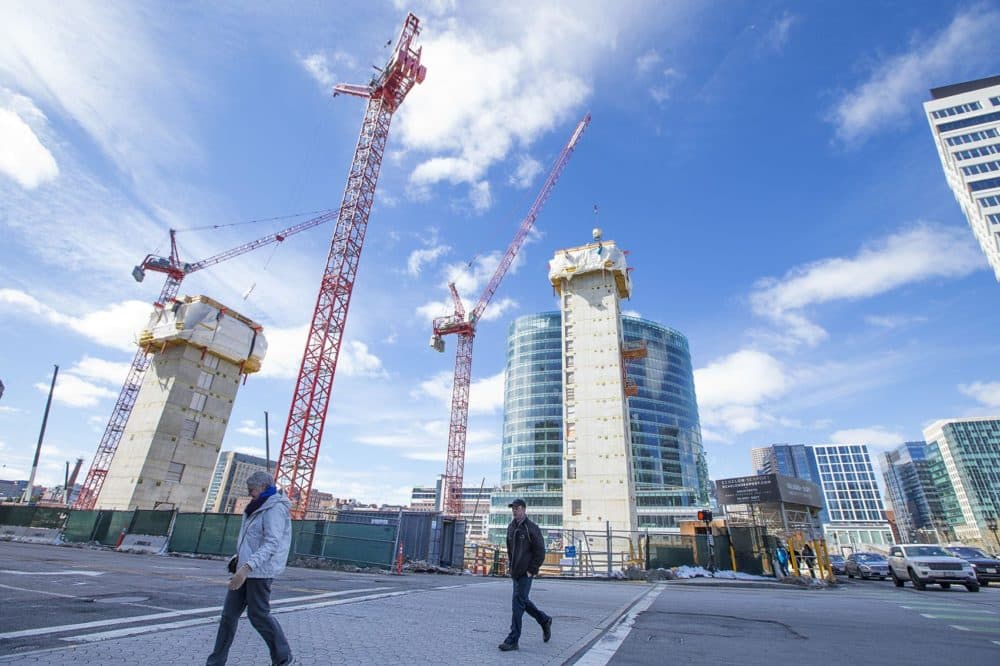Advertisement
Commentary
Boston’s building boom presents big challenges for the next mayor to solve

From my vantage point on the Massachusetts Ave. bridge (officially the Harvard Bridge), I count 11 construction cranes looming over Boston’s skyline. Many more are hidden. Boston is in the midst of the largest building boom in its history.
There are now nearly 100 major development projects going on in the city — narrowing and blocking streets with trucks, heavy equipment and Jersey barriers; closing sidewalks; filling the air with fine concrete dust that we are breathing deep into our lungs. And then there is the constant noise — pile drivers and jack hammers, trucks loading and incessantly beeping. At some sites, like Parcel 12 in the Fenway, the construction has gone on all night for several months, disturbing the sleep of hundreds of people, and for some, I would expect, compromising their health.
The next mayor of Boston, and the Boston Planning and Development Agency, will face some difficult decisions about whether some of the innumerable project proposals before them should go forward.
The question at the heart of all this, is: Why is this building boom going on now?
We are told by developers that we desperately need the many million square feet of new office space that will be added. But there are now more than 4 million square feet of empty office space in Boston’s towers, and another 2 million square feet in long term leases that are not being renewed. It is clear that a large proportion of Boston’s workers will continue to work from home long after the pandemic subsides, perhaps indefinitely.
Lord and Taylor is gone. So is Crate and Barrel. In this one mile of Boylston Street alone, I counted 22 restaurants and stores that either have 'Retail Space for Lease' signs posted ...
We are told that we need more restaurants and stores, that these buildings can house. But a walk down Boylston Street from Mass. Ave. to the Boston Garden will convince anyone that there are now countless restaurants and stores in the city available for rent or sale, including spaces once home to iconic businesses. Lord and Taylor is gone. So is Crate and Barrel. In that one mile of Boylston Street alone, I counted 22 restaurants and stores that either have “Retail Space for Lease” signs posted, including some with many thousands of square feet, or that have closed, are being remodeled and have not yet posted their signs.
And, finally, we are told we need more housing. That is certainly the case, but what Boston needs is affordable housing, not more condos costing $1 million or more that only the very wealthy can afford.
Boston is an old, small city filled with narrow winding streets. It is highly subject to gridlock, as anyone trying to move around the city during rush hour will attest, gridlock that will increase manyfold as construction sites proliferate, blocking traffic.
Advertisement
This will be a particular problem in the Fenway, where five large buildings are now going up, and there are plans for several more in coming years. Traffic barely moves now during Red Sox home games and concerts at Fenway Park, and the MGM Music Hall, a 5000-seat auditorium, hasn’t even opened yet. What will happen when eight new buildings, proposed to be built around Fenway Park, are under construction?
But the most dangerous consequence of the building boom for the people of Boston is the effect it will have on climate change, to which our city is highly vulnerable
And with more traffic and more construction in the Fenway, how will emergency vehicles gain access to those who live there? And how will ambulances navigate the area, one of the city’s most important corridors to one of the largest concentrations of hospitals in the country?
But the most dangerous consequence of the building boom for the people of Boston is the effect it will have on climate change, to which our city is highly vulnerable — not only to extreme heat waves, but to more violent Nor’easters and hurricanes, to storm surges, rising seas and flooding.
Every new high-rise building releases massive amounts of carbon dioxide during its construction — from the combustion of fossil fuels used to power all the equipment, to the manufacture of cement, an enormously polluting process that accounts for 8% of all carbon dioxide emissions worldwide. And every new square foot of building space adds more carbon dioxide to the atmosphere.
Boston has highly ambitious goals to reduce its carbon emissions — to be carbon neutral by 2050 — as it struggles to help prevent the threat of a catastrophic medical emergency for Bostonians. Indeed Boston and Massachusetts are performing better than almost every other city and state in the nation. But if we are to have any chance of meeting our stated goals, the current unchecked building boom must come to an end and our old buildings should be retrofitted so they are as energy efficient as possible.
And if a new high-rise building is proposed, it should be approved only if the amount of carbon it adds to Boston’s footprint is far outweighed by the absolutely essential housing, offices, good and services that it will provide for the city and its inhabitants.
That is the challenge for the next mayor.
